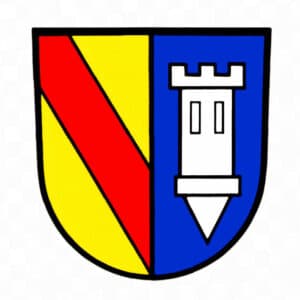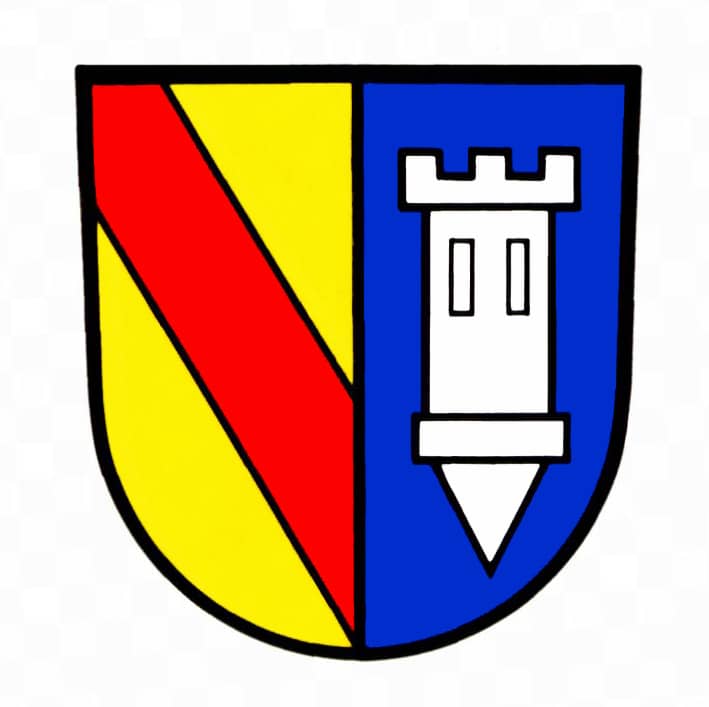Ettlingen is a town south of Karlsruhe in Baden-Württemberg . Bruchsal, it is the second largest city in the Karlsruhe district and a middle center for the surrounding communities.
Since the regional reform in Baden-Württemberg in the early 1970s, the urban area has consisted of the core city and the districts of Bruchhausen, Ettlingenweier, Oberweier, Schluttenbach, Schöllbronn and Spessart.
Here are excerpts from the community website :
Settlement by the Romans in the first and second centuries AD, numerous finds such as stones of the gods, tools, vessels and coins prove this.
788: The first written evidence of Ettlingen, then “Ediningom”, can be found in a deed of donation from the Weißenburg monastery in Alsace. The year is considered the year Ettlingen was first mentioned, even if the settlement as such had existed for a long time.
The affiliation with the Weißenburg monastery is shown in the seal, which shows a key. This is the symbol of St. Peter and Paul. Above this lies the diagonal right-hand bar of Baden. This representation is located in the town hall, 1st floor, in the transition from the town hall to the tower.
965: The village called “Ediningom” received market rights from Emperor Otto the Great and thus established the central local function of the place.
1192: Presumably this year, the Ettlingen market was made a city by Emperor Heinrich VI, a son of Barbarossa, and thus received the right to fortify itself. The city wall around today's core city, which is still visible today, was built in several expansion phases.
The southern old town between Alb and AVG-Trasse will be fortified twice with a double ditch system, the northern old town between Alb and Pforzheimer Straße will receive a simple fortification but towers such as the Lauerturm at the corners for additional protection.
In order to maintain the functionality of ditches and walls, a considerable amount of money had to be allocated to the city budget. When the French achieved a breakthrough in 1689, the city wall began to decline as an effective protection against enemies. In the 18th century the ditches were drained and used as pasture. Today they are the wide thoroughfares.
1219: The Baden margrave Hermann V becomes Ettlingen's fiefdom, while instead of the Weißenburg abbey, the Baden house monastery Lichtental takes over the patronage of St. Martin's Church from 1245. The Weissenburg symbol - the Peter's key - disappears from the Ettlingen city coat of arms and makes way for the white tower on a blue background alongside the Baden colors of yellow and red.
1462: In addition to the existing sawmills, oil mills and grinding mills, Margrave Jakob I of Baden built the first paper mill in Baden. It founded an economic sector that consolidated Ettlingen's reputation as a paper manufacturing town.
1689: During the War of the Palatinate Succession, the city was almost completely burned down by troops of the French King Louis XIV. All documents and church records were burned.
The following thirty years were devoted to the reconstruction of public and private buildings. This decisive moment is recorded in a glass window on the 1st floor of the town hall: Margravine Augusta Sibylla receives the building plan for the St. Martin's Church from the hands of master builder Ludwig Michael Rohrer, as it was to be built as a baroque hall church after its destruction and still exists today.
Other important buildings in the city such as the town hall, the castle and private buildings, some of which were built according to an identical building plan, are grouped around this scene.
1727:Margravine Sibylla Augusta chooses Ettlingen as her widow's residence. Court architect Johann Michael Rohrer was commissioned to rebuild Ettlingen Castle. Rohrer gives the south wing baroque features, calls on the fresco painter Lucca Antonio Colomba and the plasterer Donato Riccardo Retti to design the interior, and finally expands the existing palace complex to include a palace chapel at Margravine Sibylla's request. The chapel is consecrated to Johannes Nepomuk, a Bohemian cleric and martyr who has just been elevated to the honor of a saint, and to whom the Margravine feels connected, not least for reasons of compatriotism (she grew up in Schlackenwerth near Karlsbad). That's why she hired the best fresco painter of her time, the Bavarian artist Cosmas Damian Asam, to decorate the Ettlingen castle chapel with wall frescoes and a dome painting based on the life, suffering and death of her favorite saint. Asam completed this extremely large-scale work within ten weeks in the summer of 1732.
The picture shows a view of the baroque rooms in the south wing of the palace along the AVG route.
1737/1738: In the same year in which the Baroque reconstruction of the nave turned St. Martin's Church, which dates back to Franconian times, into a stone showcase of all Western architectural forms, the citizens of Ettlingen were able to complete the construction of their new town hall. With the beautifully structured facade made of red sandstone - designed by Johann Peter Ernst Rohrer, the brother of Sibylla Augusta's court architect - the defiant tower and its baroque tower dome, it forms the architectural counterpoint to St. Martin's Church and is one of the city's architectural landmarks.
1771: The Catholic family of the Baden-Baden margraves dies out, Ettlingen becomes part of the Protestant margraviate of Baden-Durlach.
1796: “Battle of Malsch” or “Bataille d'Ettlingen” - the name on the Arc de Triomphe in Paris - in which Archduke Charles of Austria and the French general Moreau fight in front of the gates of Ettlingen.
1805/1809: Napoleon briefly takes up quarters in Ettlingen Castle during his campaigns.
1836: The spinning and weaving mill is founded and soon becomes the third largest employer in Baden. With it, skilled workers from predominantly Protestant countries - Württemberg, Switzerland and Alsace - come to Ettlingen and ensure a denominational mixing of the population and the establishment of a Protestant parish.
1848/1849: Ettlingen provides an important leader in the Baden revolution, Philipp Thiebauth, who goes into exile for several years after the uprising fails. He reached Liverpool in England via Switzerland and returned after the amnesty as the elected mayor of Ettlingen.
1870/1871: After the Franco-German War, Ettlingen's upward development continued steadily. The returned Philipp Thiebauth played a significant role in this, being elected mayor of the city at least three times in a row from 1870 onwards. His era included the construction of a water pipe and a schoolhouse, the expansion of the non-commissioned officers' school in the castle and the creation of the conditions for the construction of the Albtalbahn, which was put into operation around ten years after his death in 1897.
1894: The Lorenz machine factory moves to the railway line and thus lays the foundation for Ettlingen-West.
1927: On the occasion of an incorrectly celebrated city anniversary, today's B3 is opened as a bypass.
The Veterinary Malsch.de practice is located 10.3 km from Ettlingen via the B3 in Einsteinstr. 6, 76316 Malsch.


